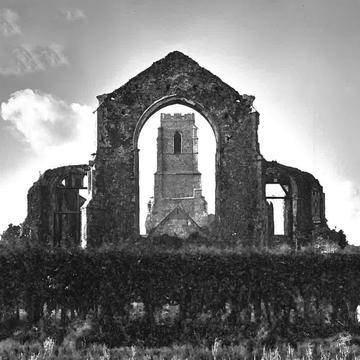In May 2020 the Heritage Partnerships Team hosted an online workshop with the Churches Conservation Trust to explore opportunities for collaborative projects. Following on from this workshop we have partnered with the CCT to secure funding for a range of initiatives.

The church of St Andrew at Covehithe. © CCT
Parish churches are a ubiquitous and iconic part of England’s national heritage. 45% of all Grade I listed buildings in England are parish churches. The question of how society manages historic places of worship is going to be one of, if not the most, significant heritage issue for the next decade. What happens when a church closes? How can the historic structure be re-purposed to serve local communities when a church ceases to be a place of worship?
These are two of the questions that a team of Oxford researchers are seeking to provide answers to in collaboration with the Churches Conservation Trust (CCT), who care for 365 parish churches that are no longer in regular use for worship, and the Church Commissioners, who are the Church of England body tasked with managing the re-use of churches.
One area of focus, developed in partnership with the Said Business School and doctoral researcher Jessica Stitt, explores the dynamics of the heritage skills labour market. In Summer 2020, supported by a grant from the Higher Education Innovation Fund, Stitt applied her knowledge and understanding of organisational and management research practice to map the existing labour market for heritage skills. A follow-on project was awarded a KE Seed Fund grant in December 2020, and Stitt continues to work closely with the CCT to research the motivations and attitudes of heritage contractors. This collaboration is enabling a much more nuanced understanding of the current labour market which will, in turn, enable the CCT to plan effective interventions in order to build capacity.
Paralleling this work exploring labour market interventions, University of Oxford researchers are providing critical thinking to underpin and enhance potentially significant changes to legal policies surrounding historic parish churches. This project, developed in partnership with the Church Commissioners and CCT, was awarded funding from the University of Oxford’s Strategic Priorities Fund: Policy Engagement in January 2021. Led by Dr Peter Petkoff and Eleanor Townsend, this project has convened specialists from around the world to debate and discuss the Mission and Pastoral Measure 2011, the current system for managing churches which are no longer in use for regular worship. Research questions include:
- how do other bodies (e.g. state-funded churches in Europe) manage the formal closure of a church and its re-use?
- what aspects of existing secular planning legislation can be translated and adapted to the CofE context to encourage creative re-use of historically significant buildings?
- how can a revised MPM build upon the 2011 Localism Act to encourage local community agency and autonomy, with particular focus on community asset transfer models?
- how do other bodies (e.g. electoral commissions, Local Authority ward alterations) change their administrative geographies?
Both projects demonstrate the rich interdisciplinary conversations that are enabled through close collaboration with heritage organisations, and the potential for new and innovative research to feed into significant interventions to conserve and share the remarkable heritage assets that are parish churches with as wide a range of people as possible.
Churches Conservation Trust
TORCH Heritage Programme